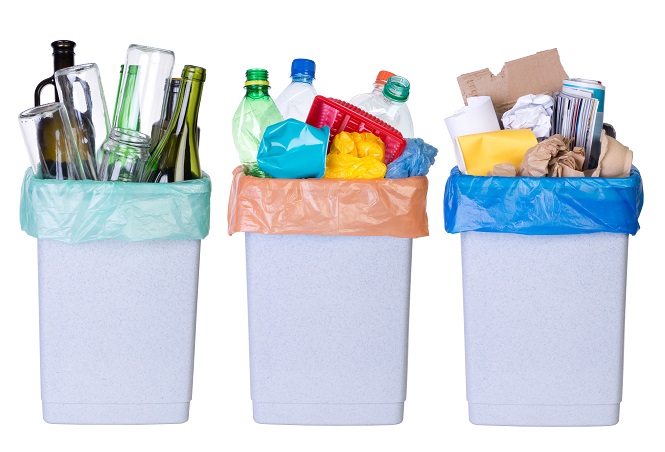
Recycling normally seems like a pretty safe, straightforward topic. Who wouldn’t want to save the trees and reduce waste? But there’s some nuance to the topic. One of the raging debates is single stream recycling versus source separation recycling. So what is it, and why should you care? Because it’s a debate addressing cost, possible contamination of recyclables and convenience to the homeowner.
Put in its most basic terms, source separation means customers sort their own recyclables. This system may also be called sorted stream recycling or dual stream recycling. Conversely, single stream recycling means recyclables do not have to be sorted.
The Single Stream Advantage
On first glance, single stream looks like the most convenient option.
The University of Wisconsin (UWM) lists several advantages to the system:
- People are busy and crave convenience, so single stream could possibly lead to more people deciding to recycle. UWM gives the case study of Madison, WI. When the city switched from source separation to single stream in 2005, recycling increased by 25 percent.
- On the trash collector’s end, single stream means reduced costs for cheaper, easier to operate single-compartment trucks.
- The ease in collection leads to less loose waste in the streets.
- Single stream also provides a reason for recycling systems to update their processes, which often results in adding a wider array of materials that can be recycled. The product UWM mentioned was the amount of paper grades collection can handle after updated processes.
- Collectors save money, which could mean 5-25 percent savings on average, resulting in possibly more money back to local governments.
But It Has Its Cons
But nothing’s perfect. The Container Recycling Institute, a nonprofit devoted to making North American “a global model” for quality recycling, lists several cons related to single stream recycling: - There’s a concern over glass shards and PET bottles contaminating paper loads and causing issues in paper mills.
- Glass, plastic and aluminum containers can cross-contaminate each other.
- Scrap material quality is much lower under the single stream model, resulting in lost revenue.
- While collection costs are lower, processing and contamination disposing costs jump to about $3 more per ton with single stream. Overall, single stream appears to be more expensive.
What About Source Separation?
So, if single stream has its cons, what makes source separation so great? Biffa, one of the largest waste disposal companies in the UK, argued that, “The householder is ideally placed to act in a way in which dry recyclables (and organic materials) are kept out of the waste, reducing both contamination and the quantity of residual waste for final disposal.” Furthermore, Biffa explained that basically, the more the homeowner and collectors get involved in the early stages of sorting, the more quality recyclables there are that are ready for processing.
Friends of the Earth, an environmental organization out of the UK, listed several pros for source separation. It mentions:
- Source separation has a reduction of contamination and increase in materials to be recycled.
- Fuel costs are lower on curbside separation vehicles.
- There are more local jobs for sorters, plus using a real human to sort means they can leave feedback to homeowners about what can be picked up and what can’t.
- Additional compartments in the source separation truck can accommodate for odd items like batteries.
- The total cost for source separation is lower.
- The overall revenue for materials increases with source separation. Paper isn’t contaminated with glass. Metals separated out earlier are more pure (manufacturers find pure aluminum more useful for cans, for instance). Separated, pure glass can be re-melted, rather than sold off as an aggregate.
Yet, at the same time, that just leads back to the pros of single source recycling. Source separation could have less recycling participation and mean more manpower.
So who’s the winner? What is the right way? While single source is more convenient, it’s also more expensive. The community pays for the convenience. But while source separation cuts costs and boosts the quality of what is recycled, it could lead to lower recycling participation. Nothing about this debate is black and white. Perhaps the answer lies in the needs and priorities of the community.
 Recycling normally seems like a pretty safe, straightforward topic. Who wouldn’t want to save the trees and reduce waste? But there’s some nuance to the topic. One of the raging debates is single stream recycling versus source separation recycling. So what is it, and why should you care? Because it’s a debate addressing cost, possible contamination of recyclables and convenience to the homeowner.
Put in its most basic terms, source separation means customers sort their own recyclables. This system may also be called sorted stream recycling or dual stream recycling. Conversely, single stream recycling means recyclables do not have to be sorted.
Recycling normally seems like a pretty safe, straightforward topic. Who wouldn’t want to save the trees and reduce waste? But there’s some nuance to the topic. One of the raging debates is single stream recycling versus source separation recycling. So what is it, and why should you care? Because it’s a debate addressing cost, possible contamination of recyclables and convenience to the homeowner.
Put in its most basic terms, source separation means customers sort their own recyclables. This system may also be called sorted stream recycling or dual stream recycling. Conversely, single stream recycling means recyclables do not have to be sorted.